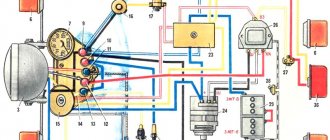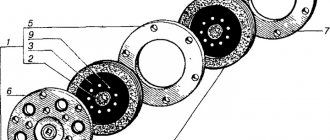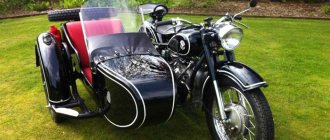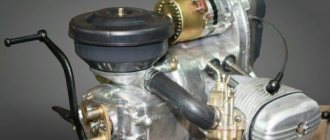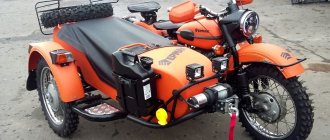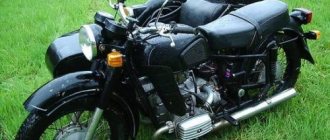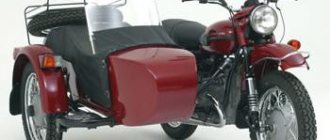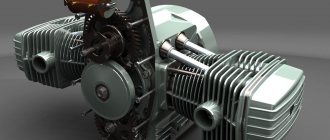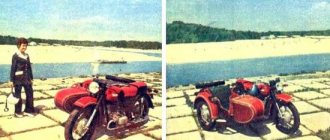Technical characteristics of the motorcycle MT 16 Dnepr
| Engine volume, cm3 | 649 |
| Power, hp | 38 |
| Number of cylinders | 2 |
| Number of cycles | 4 |
| Maximum speed, km/h | 125 |
| Gasoline consumption, l | 8 |
| Tank volume, l | 19 |
| Transmission | 4-speed |
| Dimensions (w/h/d), mm | 1700/1080/2430 |
| Weight, kg | 350 |
The four-stroke engine with two cylinders produces 38 hp. at 5900 rpm. The fuel supply is regulated by the carburetor. An OHV distribution system is used. The engine is air cooled. Each cylinder is equipped with two valves. The cylinders are located oppositely. The engine is started by a kick starter. There are no strict requirements for fuel quality. Relatively high power is achieved through the fuel supply system, which leads to high gasoline consumption.
The 4-speed transmission is equipped with reverse gear. The suspension is reliable and powerful. The front fork is telescopic and equipped with a shock absorber. The rear suspension is lever type with shock absorbers. The braking system is reliable and durable. Mechanical drum brakes are quite enough to stop a 350-kilogram vehicle.
Motorcycle with the Dnepr brand
Motorcycle "Dnepr-11". The “Dnepr-16” model with a sidecar wheel drive can be easily distinguished from the one shown in the picture by its separate saddles.
The Kiev Motorcycle Plant has begun serial production of new machines “Dnepr-11” and “Dnepr-16”. The first replaced the Dnepr MT10-36 road model, the second replaced the Dnepr-12 off-road motorcycle. During their development, the latest requirements of active and passive safety standards, as well as the wishes of motorcyclists, were taken into account.
First, let’s talk about the new components that are common to both models. These are the stroller wheel brake, parking brake, lights and combination switches.
Improvements refer to design factors that improve traffic safety. The braking distance from a speed of 60 km/h has become 5 meters shorter. The mechanically operated parking brake acts reliably on the rear wheel of the car and the wheel of the sidecar, holding the motorcycle on a slope. From the common pedal, the braking force is transmitted to an unequal-arm equalizer lever, which distributes it between the brakes of the rear wheel and the sidecar wheel in a ratio of 7:3. The equalizer also serves to ensure that the brakes of both wheels are activated simultaneously. If play or wear appears in the drive of one of the mechanisms, this will not affect the efficiency of their operation, since all errors will be compensated by turning the equalizer.
The brake drive at the stroller wheel is cable driven. A stop with an adjusting bolt is welded to the pedal. If the brake cable stretches excessively or breaks, the lower arm of the equalizer will rest against the bolt. Then the driver can only use the rear brake.
The parking brake is installed in the middle part of the frame on its right tube. To apply it, you need to press the pedal all the way with your foot, then lower the brake handle with your hand and turn it 90 degrees outward. In this case, the bolt located in the lower part of the handle will touch the special stop of the pedal and fix it in a braked state.
The motorcycle is equipped with new lighting devices, a combined rear lamp and direction indicators. They differ from those replaced by better lighting parameters. In order to improve the driver's position, the steering wheel has been given a new shape; Combination switches are mounted on it, which have also undergone changes. The turn signal switch is on the left. It is structurally combined with a signal button and a high and low beam switch.
The lighting mode switch (it's on the right side) has three positions: the far right (“D” - day) - driving in the daytime; average (intermediate) - driving at night in the city; extreme left (“N” - night) - driving at night outside the city. In the same unit there is an emergency ignition switch.
A brake light sensor is installed on the front brake lever bracket. Now the signal lights up not only when you press the pedal with your foot, but also when it is fixed with the brake lever.
The Dnepr-16 model has a drive to the sidecar wheel, which provides higher maneuverability in difficult off-road areas.
The motorcycle is equipped with an overhead valve engine with a displacement of 650 cm3, unified with the Dnepr-11 engine. An asymmetrical cylindrical differential is mounted in one unit with the main gear. It distributes torque between the rear wheel of the motorcycle and the wheel of the sidecar in a ratio of 19:11. From the differential, through the transverse cardan shaft, the moment is transmitted to the stroller gearbox, mounted on the suspension arm of its wheel. This shaft is structurally designed in such a way that, due to its own elasticity when twisted, it softens the shock loads that arise in the drive of the stroller wheel when moving.
The Dnepr-16, unlike the Dnepr-11, has two separate saddles.
The plant continues to work on improving the machines it produces. This year it is planned to master the production of a new air filter with a paper replaceable element, which will significantly improve air purification. New carburetors of the K-63 type will be used, which are more stable in adjustments. A car equipped with them becomes more economical.
In the future, it is planned to make changes to the gas distribution mechanism in order to reduce the thermal stress of the engine, and therefore increase its service life. Preparations for the production of a new side trailer are underway.
Innovations will affect not only the design of motorcycles, but also the manufacturing processes of their parts and components. Taken together, the measures taken should significantly increase the technical level and quality of Dnepr motorcycles.
V. SVYATNENKO, engineer, Kyiv
Disadvantages of the model
- High fuel consumption.
- The oil system has flaws.
- Difficulties in setting up the synchronization of the operation of two carburetors, which affects fuel consumption.
- The stroller shakes quite a lot when driving off-road.
Dnepr 16 ceased production in 1992. The motorcycle was very popular among residents of rural areas due to its good cross-country ability, as well as the ability to carry large loads. Despite the fact that the maximum load specified by the manufacturer is 270 kg, exceeding this weight had virtually no effect on the performance of the motorcycle.
Unfortunately, due to age, the motorcycle has lost its original qualities and it is quite difficult to resurrect this model. In addition, high fuel consumption and the need to devote a lot of time to repairs and maintenance discourage many from purchasing this equipment.
A trip on the Soviet "Dnepr" with a stroller replaces Dmitry's morning jogging
Share
Tell
Share
Tweet
Share
Some people are fond of collecting stamps, others go to the gym every day, and still others cannot live without Soviet motorcycles. We met with one of these people to create the “Garage” section. Meet Dmitry, the owner of the Soviet Dnepr motorcycle with a sidecar. He told us about his hobby and even took us for a ride in an unusual vehicle.
- This is the Dnepr from the Kyiv Motor Plant. I had a long series of meetings and partings with him. I owned it from 1998 to 2007. Then I sold it, and a few years ago I decided to return to it again. I decided to assemble a motorcycle with a sidecar. First we got the frame, the motor, then something else. He was a little different, and what you see now is an attempt to create an authentic image. I didn't paint it or do anything with the appearance of the bike, I just wanted it to ride and look the way it is. But this is quite difficult, because domestic technology requires selective assembly, correct application of hands and individual fitting of parts.
It shows that this is a paramilitary modification. It is equipped with a stroller wheel drive, numerous brackets and mounts for typical equipment. The motorcycle was created for harsh operating conditions. In fact, the quality of production of equipment components for the army is really higher. I tried to find original parts, but even suitable wheels cannot be easily bought in a store. You have to look for it somewhere, make it, order it. Many thanks to my friends and all those people who helped me - without them this would not have been possible.
I was surprised, but its fuel consumption is quite low, about 6 liters per 100 kilometers. This came as a surprise to me. The curb weight of the motorcycle is about 400 kilograms, so you won’t be able to ride it - the maximum speed is 85 kilometers per hour.
I assembled the engine of this motorcycle in 2004-2006. This engine is very individual. It was quite difficult to search for all this; I had to go to St. Petersburg, Moscow, and I had to order something from the Kiev Motor Plant itself. In principle, a lot could be bought here, but you would have to wait a long time, and the price would be much higher. “Russian Post” did not work so quickly back then, there was no online trading at all. Therefore, I had to travel a lot myself, although tickets were cheap back then. You could go to Moscow for 400 rubles.
You need to get used to the controls. Still, a motorcycle with a sidecar wheel drive, albeit with a differential. In fact, it is a car without one front wheel. In general, it is quite stable. Even when you manage to put it into a skid, it somehow stabilizes itself.
How I started driving in winter. On December 28, I left the house, it was very slippery. I slipped and fell... and almost broke my leg, leaving a huge bruise. I was upset and thought that it’s probably not worth walking in this weather, it’s better to drive. I ordered tires in St. Petersburg, sent them to be studded, and now I’ve been driving since December 31st.
When you ride it on our roads, it shakes quite violently, it’s an old motorcycle, it has practically no loyalty to the driver. A trip in the morning is like jogging or gymnastics. Very invigorating.
I carry passengers in a stroller. People are happy, they say it’s great, some even then think about buying something similar for themselves. In our city there are many people who ride motorcycles with sidecars. I personally know four people who chose such a means of transportation in winter; there are more in summer.
Motorcyclists are quite a close-knit community. Many of them know each other. But if you attend some events, you will see that the owners of Soviet and imported motorcycles sometimes look at each other from a certain distance.
I have several friends - serious adults, with higher education, excellent specialists in their fields, but they prefer to ride Soviet motorcycles. They are doing well and they have a Soviet motorcycle because they like it. This is a technique that is interesting. Even the instructions for such motorcycles say: “The motorcycle is intended for cultural, business and tourist trips,” very intelligently. These motorcycles are a legacy of the era. That era when knowledge was power.
The modern motorcycle community is somewhat consumerist. Some people buy a motorcycle and immediately think about how they will sell it in order to also make money. People who buy Soviet motorcycles are forced to communicate closely with them; they will definitely need to repair, adjust, and improve something. It's not even a hobby, it's self-realization. People realize themselves in different ways, some with the help of domestically produced motorcycles.
Similar motorcycles are still produced in Russia. The Irbit Motorcycle Plant currently produces exclusively motorcycles with sidecars. At one time they existed in parallel with the Kyiv Motor Plant. One produced a few motorcycles for the police, and the other for the army. And then the USSR collapsed, and the Kiev Motor Plant did not survive. A new domestic motorcycle with a minimum configuration costs just over half a million rubles.
How do people react? Children pull their parents by the sleeve and rejoice: “Mom! Dad! Motorbike!" A motorcycle with a sidecar gives people delight. People are smiling. Me too. Even if it's cold.
Which Dnepr models are the most common?
In the 50s, the plant began preparing the first heavy motorcycle for mass production - the M-72. This motorcycle had a 22-horsepower engine and weighed 330 kilograms. The maximum speed of the M-72 was 95 km/h. This model is considered the prototype and sample of the Dnepr series motorcycles. The K-750 model and the improved modification K-750M have become closer to the same “Dnepr”. This version, in comparison with the K-750, was distinguished by the presence of 4 additional horsepower and fuel consumption per hundred reduced by 1 liter. A durable engine paired with a gearbox is one of the main advantages of the motorcycle.
At the end of the 60s, the plant introduced a model that was later destined to become legendary - the K-650 or simply MT-8. The disadvantage of the K-750 and K-750M was considered to be an insufficiently reliable crankshaft. Defects formed on its surface after 20 thousand km. On new models, there was no damage to the crankshaft even after 40 thousand km. The plant’s engineers used all the innovative solutions available at that time, due to which they managed to increase the service life to 1000 operating hours.
But the most popular model among local motorcyclists is the MT-9. In just three years, the plant sold over 200 thousand km. There have been no global changes in this motorcycle compared to the MT-8: the same power rating, 27-horsepower engine, maximum speed of 100 km/h and weight of about 315 kg. This is the first MT series motorcycle to receive a turn signal.
The manufacturer focused its main efforts on increasing the comfort of the motorcycle and reducing fuel consumption to an acceptable level. For a long time, the developed design, which had proven itself in practice from a positive point of view, remained unique and unchanged. The following motorcycles MT-10 and MT-10-36 were not much different from each other. The only thing is that the MT-10-36 was equipped with an even more powerful 36-horsepower engine and increased the comfort of driving the motorcycle.
Why did Dnepr quickly sell out?
If we take into account the design of the Dnepr motorcycle, then, for example, against the background of one of the main competitors - Ural - the equipment had several obvious advantages. First of all, this is a repairable crankshaft. The crankshaft was one-piece, with plain bearings on the lower heads of the connecting rods (the connecting rods were collapsible).
This production technology made it possible to experience several obvious advantages of the motorcycle:
- the possibility of repairing the connecting rod and piston group;
- possibility of restoring the crankshaft;
- increased service life of the liners due to their increased contact area with the shaft.
But this also has some disadvantages, for example, if the lubricant supply is stopped, the liners quickly “die”. There is still no clear answer to the question of which engine is more durable - the Ural or the Dnepr. With regard to the gearbox, the situation is somewhat different. The gearbox on the MT-804 model was particularly reliable and durable. This gearbox has clear and smooth gear shifts. Another advantage for which many motorcyclists chose the Dnepr is its high-torque performance. The brutal appearance also played a significant role in the popularity of the motorcycle. The “classic” double seat also found its admirers.
